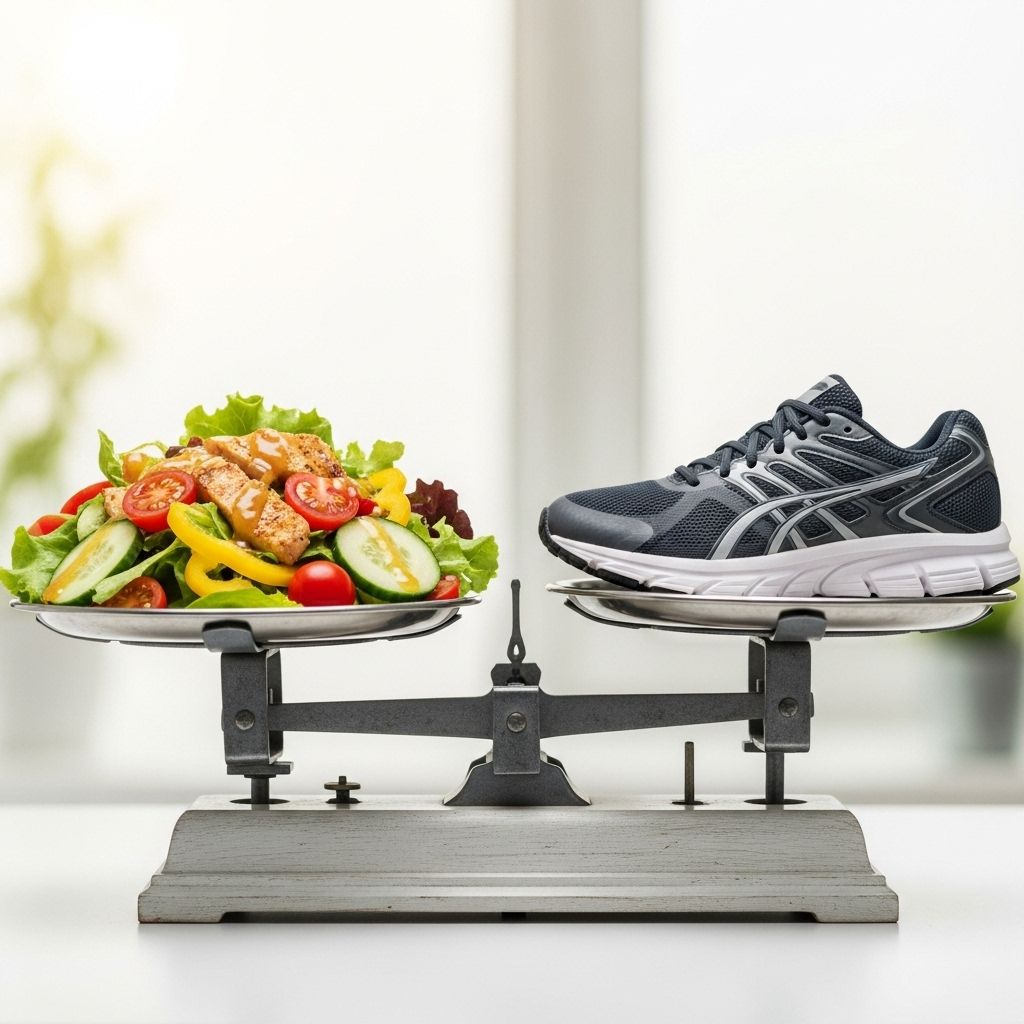Should You Eat Back Your Exercise Calories? A Dietitian’s Insight
Understand whether you should consume the calories you burn through exercise and how it impacts weight loss and nutrition goals.

Should You Eat Back Your Exercise Calories?
If you use calorie-tracking apps such as MyFitnessPal, you’ve likely encountered a growing question: Should you eat back the calories you burn through exercise? This topic is a common source of confusion for those aiming to lose weight and optimize nutrition. Many people wonder if consuming those calories undermines their fitness efforts or aids in maintaining balance. In this article, we’ll explore the science behind exercise calories, bust common myths, and give practical, evidence-based guidance to help you decide what’s best for your goals.
Understanding Exercise Calories and Energy Balance
Exercise calories refer to the extra calories you expend through physical activity in addition to your regular daily activities. Your body already burns calories at rest to sustain basic functions such as breathing, circulating blood, and maintaining body temperature (basal metabolic rate, or BMR). You also burn additional calories through routine movement (non-exercise activity thermogenesis, or NEAT) and digestion (thermic effect of food).
When you add structured workouts—whether it’s running, spinning, weightlifting, or yoga—you increase your total daily energy expenditure. The calories burned through these activities are often called exercise calories.
- BMR: Calories burned at rest, making up the majority of daily calorie expenditure.
- NEAT: Calories burned from unstructured activities (e.g., walking, fidgeting).
- Exercise Activity: Calories burned during formal workouts.
- Thermic Effect of Food: Calories used to digest and process food.
For weight loss, the primary goal is maintaining a calorie deficit (burning more calories than you consume). But where do exercise calories fit into this equation?
How MyFitnessPal Calculates Exercise Calories
MyFitnessPal and similar apps estimate the calories you burn through exercise using METs (Metabolic Equivalent of Task). The app factors in personal details such as weight, age, gender, activity type, and intensity to estimate calorie expenditure. Here’s a simplified breakdown:
- Input: Your weight, age, gender, and baseline activity level (selected when you set up your profile).
- Type and duration of exercise: Entered manually or synced from fitness trackers.
- MET value: The app references a database of MET values, representative of the energy cost of activities compared to rest.
The calories burned calculation typically looks like this:
Calories burned = MET value × weight in kg × duration (hours)Once you log exercise, MyFitnessPal adds the estimated calories burned to your daily calorie budget. If your baseline was 1,500 calories and you burned 300 calories exercising, your new calorie target displayed would be 1,800 calories.
Why MyFitnessPal Adds Exercise Calories
The logic behind this approach is straightforward: more activity means higher energy needs. If you burn more energy than the app originally projected (based on your baseline activity level), the system adjusts your calorie budget so you don’t inadvertently fall into an excessive deficit.
For example, if someone is consuming only 1,200 calories and then burns 500 calories through exercise—without eating additional calories—his or her net intake could fall dangerously low, which may slow metabolism, sap energy, and possibly increase the risk of muscle loss.
Should You Always Eat Back Exercise Calories?
This is where things get nuanced. There is no universal answer; the right choice depends on your personal goals, activity levels, and body’s response. Consider these factors:
- Your weight loss goals: A modest calorie deficit is proven to assist with fat loss while preserving muscle. Eating all your exercise calories back may erase your deficit, while failing to consume enough can result in excessive hunger, fatigue, and slowed metabolism.
- Quality of calorie estimates: Exercise calorie calculators (including MyFitnessPal) are not perfectly accurate. They often overestimate—sometimes significantly—the number of calories burned, especially for cardiovascular activities.
- Intensity and duration of exercise: On days with intense or extended workouts, eating back some of your exercise calories can help with recovery and energy.
- Listening to your body: Hunger cues, performance, and mood are indicators that help determine if your energy intake matches your expenditure.
Should You Eat Back All Exercise Calories?
Most dietitians and fitness pros recommend not eating back all of your exercise calories. Since calorie burn estimates can be inflated, eating 100% of those calories may stall your weight loss. A common suggestion is to eat back only a portion—such as 50-75%—unless you’re training at a high level or experiencing symptoms of under-fueling.
Example: If you burn 400 calories during a run, consider eating back 200-300 calories, depending on results and hunger.
Potential Pitfalls of Eating Back Exercise Calories
- Overestimation of calories burned: Apps and devices often provide inflated numbers, particularly for cardio machines like ellipticals and treadmills. Personal trackers may improve accuracy but are still prone to error.
- Compensatory overeating: Some might unconsciously eat even more than the additional exercise allowance, leading to weight gain or plateau.
- Neglect of macronutrients: It’s easy to eat back calories with empty calories (e.g., sweets, processed snacks), undermining nutrition and recovery.
- Ignoring individual variability: Age, genetics, hormonal status, and metabolic adaptations all affect calorie needs. Relying solely on app-generated numbers ignores these nuances.
Common Scenarios for Eating Exercise Calories
- Active Individuals and Athletes: High-volume training calls for an increased calorie intake, including more carbohydrates and protein to support performance and recovery. Not eating enough can lead to fatigue, reduced immunity, and muscle breakdown.
- General Fat Loss: For those aiming for moderate, sustainable weight loss, being selective about eating back exercise calories is key. This means adjusting based on results, hunger, and how your body feels.
- Rest or Low Activity Days: Minimal or light exercise days likely require no adjustment to food intake unless you’re unusually hungry or feeling depleted.
How to Decide: Eat Back, Ignore, or Somewhere In Between?
Here’s a practical approach to use when determining how much, if any, of your exercise calories to eat back:
- Track results over several weeks: Monitor weight, body composition, energy, sleep, and hunger levels to assess trends—not just scale weight.
- Adjust for overestimation: Eat back a conservative percent (such as 50-75%) of exercise calories, unless directed otherwise by a healthcare or fitness professional.
- Prioritize nutrient-dense foods: Choose high-quality proteins, vegetables, complex carbs, and healthy fats to support recovery and minimize empty calories.
- Listen to your body: Are you ravenous, fatigued, or sluggish? Adjust your intake based on individual cues, not rigid numbers.
- Avoid extremes: Refrain from going ultra-low calorie or consistently eating all your exercise calories unless your training load requires it.
Practical Tips for Using MyFitnessPal Exercise Calories
- Be honest and detailed when logging exercise—include duration, intensity, and correct activity.
- Sync with wearable devices for improved accuracy. Heart rate monitors and fitness trackers adjust calorie estimates based on individualized data.
- Review your progress monthly to evaluate whether your plan is leading to desired results. Make incremental changes as needed.
- Watch for negative calorie adjustments if your activity is lower than the baseline assumed by your profile. MyFitnessPal allows you to enable or disable this feature in settings.
- Consult a registered dietitian or nutrition expert if you’re unsure about calorie needs, especially if you have unique health conditions.
Science Behind Exercise Calories and Weight Loss
Numerous studies have investigated energy compensation after exercise. Some findings include:
- Metabolic slowdown does occur with excessive calorie restriction. This can undermine weight loss and make long-term maintenance difficult.
- Group studies show that people often overestimate both calories burned and underestimate calories consumed, leading to disappointing results.
- Strategic exercise nutrition, including eating a portion of workout calories back, can help with recovery, support muscle retention, and reduce cravings.
Common Myths About Exercise Calories
- Myth: Eating back exercise calories undoes all your progress.
Fact: Eating in line with your body’s needs maintains muscle and metabolism; the key is not to overeat beyond your overall deficit. - Myth: You should never eat them back.
Fact: On high-intensity or long-duration training days, consuming extra calories can enhance performance, recovery, and long-term progress. - Myth: App calorie counts are perfectly accurate.
Fact: These calculations are only estimates; your physical results and well-being are better guides.
Table: Pros and Cons of Eating Back Exercise Calories
| Pros | Cons |
|---|---|
| Prevents under-fueling, preserves muscle mass | Estimates can lead to overeating if app numbers are inflated |
| Supports recovery after intense or prolonged exercise | May stall weight loss if all calories are eaten back and burned estimates are inaccurate |
| Reduces fatigue and helps regulate exercise performance | Potential to choose less nutritious foods when making up calories |
| Avoids drastic calorie deficits (which can slow metabolism) | Complicates tracking for those who already have trouble with calorie counting |
Frequently Asked Questions (FAQ)
Do I have to eat back my exercise calories to lose weight?
No. Many people lose weight effectively by maintaining a consistent deficit, eating some—rather than all—of their exercise calories. However, not eating enough can cause low energy and muscle loss.
Are MyFitnessPal exercise calories accurate?
MyFitnessPal and most fitness trackers only provide estimates. These can be off by 10-50%. Consider eating back a portion (not all) to avoid excessive surplus or deficit.
How should I track my exercise calories?
For best results, use devices with heart rate monitors and update your profile settings regularly to keep calculations as personalized as possible. Always log length, intensity, and correct exercise type.
What about strength training versus cardio?
Strength training burns fewer calories during exercise but boosts metabolism post-workout; cardio burns more immediately but may not stimulate as much muscle retention. Both are valuable, though calorie calculations for strength training are less likely to be overestimated.
If I’m not losing weight, should I eat back fewer exercise calories?
If your weight loss has stalled and you’re eating back most or all of your exercise calories, try reducing the amount you eat back (e.g., eat back 50%). Monitor progress and adjust as needed.
Key Takeaways
- Eat back exercise calories conservatively: 50-75% is often reasonable for most individuals; adjust for high training loads or personal results.
- Don’t solely trust app numbers: Calorie calculations are estimates; your real-world progress and well-being matter more.
- Focus on quality nutrition: Use extra calories to support health, not just reward yourself with treats.
- Review your data and adjust: Ongoing self-assessment helps you find the right balance for both fitness and enjoyment.
If you are unsure about your specific calorie needs or struggling with energy levels, consult a registered dietitian or nutrition professional to build a plan that supports your goals sustainably.
References
- https://fitness-n-health.com/how-does-fitness-pal-measure-exercise-calories.html
- https://www.personaltrainerauthority.com/my-fitness-pal-how-many-exercise-calories-to-eat/
- https://caloriehealthy.com/how-does-myfitnesspal-calculate-exercise-calories.html
- https://caloriehealthy.com/why-does-myfitnesspal-add-calories-when-you-exercise.html
- https://support.myfitnesspal.com/hc/en-us/articles/360032623871-What-is-the-Calorie-Adjustment-in-my-Exercise-Diary
- https://www.thetechedvocate.org/how-does-myfitnesspal-calculate-calories-a-comprehensive-guide/
- https://support.myfitnesspal.com/hc/en-us/articles/360032626011-How-does-MyFitnessPal-work
Read full bio of Sneha Tete












